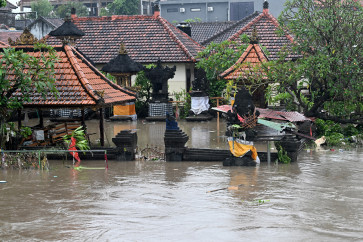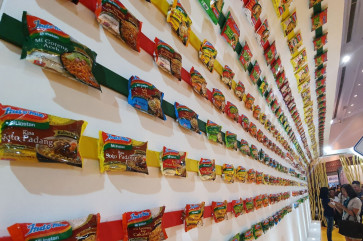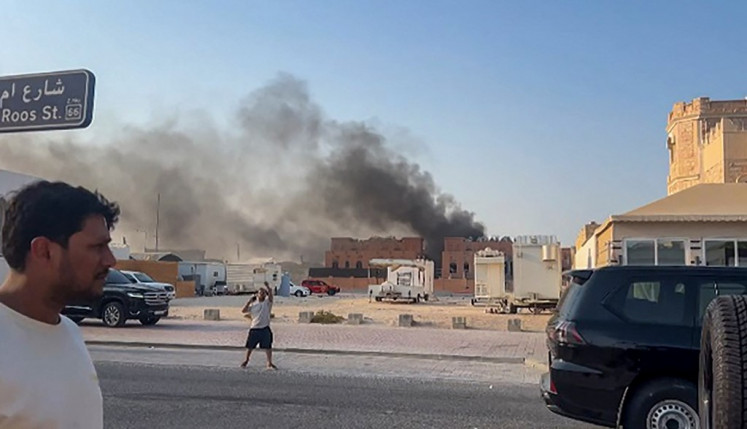Popular Reads
Top Results
Can't find what you're looking for?
View all search resultsPopular Reads
Top Results
Can't find what you're looking for?
View all search resultsThe family behind Teluk Naga candles
For luck, happiness: A worker prepares large candles at a factory in Teluk Naga, Tangerang, on Monday, days before the Chinese New Year
Change text size
Gift Premium Articles
to Anyone
F
span class="caption">For luck, happiness: A worker prepares large candles at a factory in Teluk Naga, Tangerang, on Monday, days before the Chinese New Year. It is believed that presenting candles to temples for the Chinese New Year will bring luck and happiness.(JP/Wendra Ajistyatama)
One cloudy afternoon, Can A Se, also known as Ase, 30, sat among dozens of huge red candles, carefully transcribing Chinese characters from his mobile phone screen. He was writing out the name of the person who had ordered the candles.
“I’m of Chinese [descent] but know nothing about the Mandarin language. But there’s definitely a Chinese business spirit that runs through my blood,” he said laughing, while continuing his work.
He was sitting inside his candle production factory in Teluk Naga, Tangerang, Banten, which he inherited from his father, Can Yau Seng, or Aseng, 63.
Ase recounted how his father sometimes made jokes of the rationale behind opening a candle business in 1998, when the financial crisis hit Indonesia.
“He said he started making candles to accommodate the needs of those who would like to pray and ask the Gods to grant them money and prosperity during the financial storm,” he told The Jakarta Post with a smile.
In 1998, Aseng and his brother-in-law, Tan Lie Hian, 70, bought a plot of land in Teluk Naga, around 30 kilometers from the Jakarta city center and only a stones throw away from the northern Banten coast line. Lie Hian, who had established his hio (incense) business in the 1980s, then relocated his production to the new site.
Ase currently employs 25 people from his neighborhood.
“They work from Monday to Saturday, from 7 a.m. to 4 p.m. They must be able to handle all stages of candle production,” he said, before detailing the steps, which include mixing paraffin with stearic acid and dye; molding the chemical mixture in the candle cast; and eventually packaging and packing the finished product.
Ase’s factory produces 14 kinds of candle, ranging from the small to the enormous two-meter high candles. At least six weeks before Chinese New Year, known locally as Imlek, Ase must boost his production volume to meet the increased demand.
“During Imlek, I can sell thousands of small candles, hundreds of medium sized candles and up to 60 giant candles, which are priced at Rp 15 million [US$1,100] each,” he said, while noting that his monthly revenue could reach billions of rupiah.
His products are mostly sold in the Greater Jakarta area, with most temples in the region being his chief customers. However, he also has loyal customers in Riau Islands, West Kalimantan and North Sulawesi.
Followers of Buddhism, Taoism and Confucianism order candles for their respective temples as a form of charity for the Chinese New Year celebrations. In the past, candles were only treated as a source of light, but today, many believe the bigger the candle they give to the temple the more luck and happiness they will receive throughout the coming year.
Lie Hians incense factory stands to the left of Ase’s factory. Lie Hian and his fourth son and Ase’s cousin, Tan Mong Seng, also known as Among, 49, busy themselves spraying sandalwood perfume on hundreds of sticks of incense.
“These incense are imported from China. Mine [the ones he produces] are the huge ones without fragrance,” Among said, pointing to sacks of half-a-meter long sticks of incense that were being wrapped in plastic by three of his employees.
Adding fragrance to the incense provides a soothing and relaxing sensation for the congregation during prayers. As the incense burns, its smoke is believed to contain their prayers, which are delivered to the Gods as the smokes dissipates.
“Therefore, people are willing to buy bunches of small fragrant incense sticks or a few large incense sticks in the hope the smoke will carry their messages to the Gods quicker,” Among said.
Like Ase, Among had never thought he would continue his parents’ business. Today, however, they both enjoy their work and have their own goals for what they want to achieve in their respective businesses.
“I plan to expand my market to North Sumatra. Soon I will go to Medan to find a working partner I can trust and send my products to be marketed there,” said Among.
The two cousins obviously share the same values as second generation candle and incense producers.
“There will always be a place for us in the market as long as people still worship the Gods in the temples, and as long as our parents give us their blessings to inherit the businesses,” Ase said. (vla)










